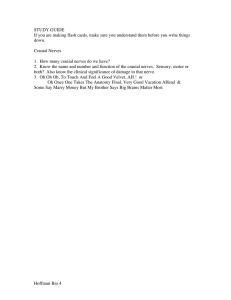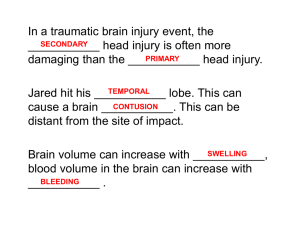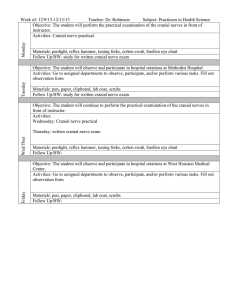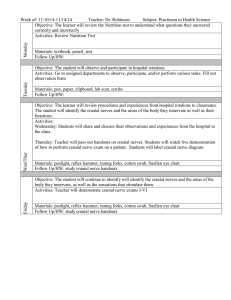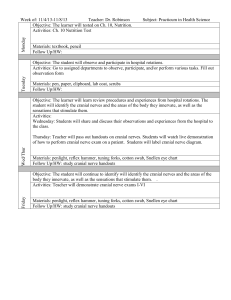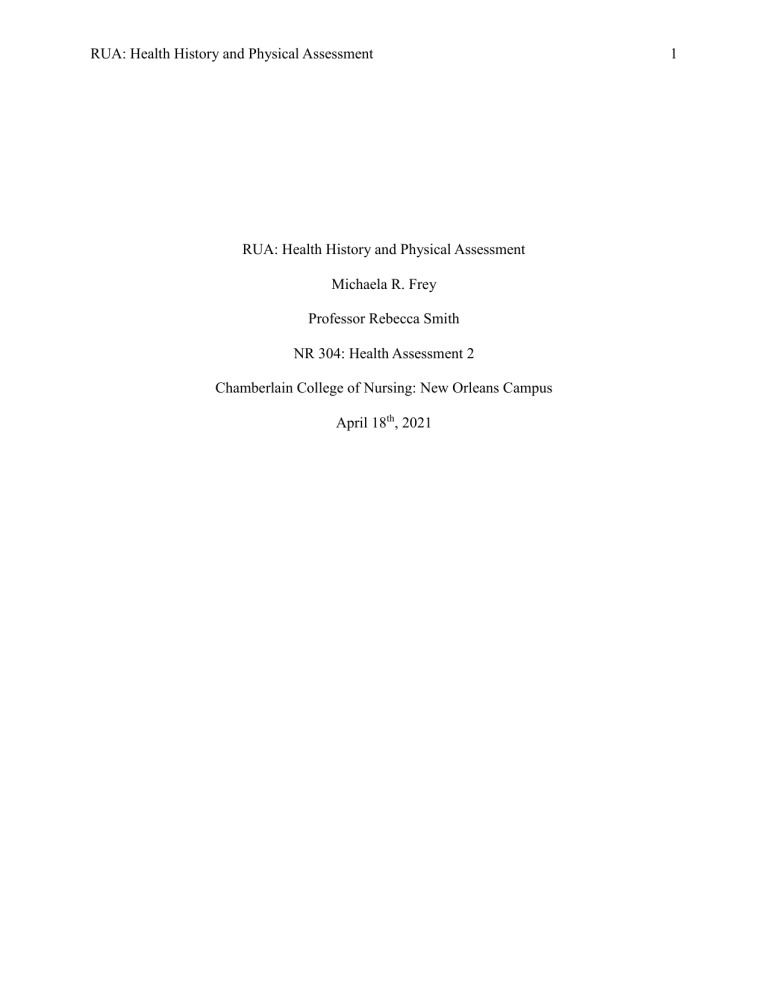
RUA: Health History and Physical Assessment RUA: Health History and Physical Assessment Michaela R. Frey Professor Rebecca Smith NR 304: Health Assessment 2 Chamberlain College of Nursing: New Orleans Campus April 18th, 2021 1 RUA 2 Health History: Subjective Data L.G is a Hispanic male who is 27 years old. L.G was born in Puerto Castilla, Honduras on January 2nd, 1994. He lives with his girlfriend of 3 years in the city of Gretna, Louisiana. L.G works full-time doing construction work all over the state of Louisiana. L.G’s reason for coming in today is to have an annual physical. He has not had a physical in a few years. L.G currently has no known illnesses or diseases. L.G has a basic understanding of a perfect bill of health. L.G is a smoker and has been smoking for about 5 years. He does not have annual checkups but does his best to stay healthy by eating a balanced diet every day. He also takes multivitamins daily. L.G does not consume alcohol. L.G reports not having any drug allergies but is allergic to cauliflower. He has had all of his vaccines back home in Honduras. His mother and father are both still living back home in Honduras and have no known illnesses or diseases. L.G reports no rashes or lesions on the skin. L.G has a total of 4 tattoos and 1 piercing. He states that there is no known history of lung diseases or disorders and reports no other known health issues during the review of systems. L.G states that he grew up in Honduras and did not have some of the luxuries that most have in the U.S. Being from Honduras and having Spanish as his first language, L.G understands and speaks English. Growing up, L.G states that his mother was very religious and practiced Christianity. His food preferences are geared towards Latin American food consisting mainly of beans and rice. L.G states that he suffers from sudden mood changes or bipolar tendencies but has not been seen by a physician for this. He also reports that sometimes he gets depressed due to his family being back home in Honduras. L.G states that his girlfriend and her family are there for him for anything he needs, and this makes him happy. Being away from his family contributes to the depression he seems to be having. I encouraged RUA 3 L.G to talk to someone when he starts feeling depressed. I let him know that he is not alone, and it is okay to talk to someone about the feelings he is having. Physical Examination: Objective Data L.G’s overall appearance is consistent with his age; he does not show any signs of acute distress, he seems to have good personal hygiene. He is in good spirits and dressed appropriately for the season. The patient is alert and oriented times four. Facial features are symmetric; his head is round in shape with no visual deformities. There are no lesions, masses, or infestations present. The sclera is white and the conjunctiva is moist and pink. Pupils are PERRLA with no signs of drainage, redness, ptosis, and strabismus. The tympanic membrane of the ear is gray and visible, there is no redness or drainage in the ear canal. There are no foreign bodies or lesions present in the nose, as well as no deviated septum and no nasal flaring. There are no nasal obstructions present. The lips, tongue, and gums have no lesions or masses, and the mucous membranes are moist and pale pink. There are no signs of masses or swelling around the thyroid and the trachea is midline. The lymph nodes are not palpable. No adventitious sounds to be noted during the auscultation of the lungs. No signs of respiratory distress, the patient is not using accessory muscles to breathe, and respiratory rate is 17 bpm. Chest expansion is full and symmetrical, there are no signs of barrel chest present. There are also no signs of scoliosis, lordosis, or kyphosis. In the cardiovascular system, there are no signs of jugular vein distention or edema, and during auscultation, there were no bruits, and no abnormal heart sounds noted. Blood pressure is 116/80 and pulse is 68 bpm. Radial and carotid pulses are +2 bilaterally. During the cranial nerve assessment, cranial nerve I was fully intact, and the patient was able to identify smells bilaterally. The patient’s visual acuity is intact with 20/20 vision. For cranial nerves III, IV, and VI ocular movements were assessed by using the 6 cardinal fields of gaze, all RUA 4 were found to be fully intact. During the assessment of the 5th cranial nerve, the facial sensations were tested using a cotton wisp, patient felt the cotton wisp in all three sensory areas of the face. Cranial nerve VII was tested by having the patient puff out their cheeks and smiling, this cranial nerve was found to be fully intact. Romberg’s test, as well as the whispered voice test, was used to check L. G’s cranial nerve VIII. Romberg’s test was negative, and the patient was able to repeat back what was said during the whispered voice test. Cranial nerves IX through XII were all found to be intact on L.G. L.G is more on the slimmer side. When assessing the abdomen, no bulging, bloating, or distention was present. While auscultating, bowel sounds were present in all four quadrants and no bruit sound was heard from the aorta. There are no masses, pain, tenderness, and no signs of guarding while performing palpation. Musculoskeletal system strength was tested with resistance in both upper and lower extremities, both were rated a 5 with a full range of motion against gravity and full resistance. No sounds of crepitation were heard while performing the test. The patient has no swelling or redness and has a steady gait. Capillary refill was assessed first in the assessment of the peripheral vascular system, it was noted as less than 3 seconds. There were no skin discolorations, swelling, pressure ulcers, varicose veins, or signs of cyanosis. Skin is smooth but not shiny and warm to the touch. Needs Assessment Based on what I have learned about this patient, he presents with no physical problems. He seems to be in very good health. I would recommend visiting a doctor annually for the depression and bipolar tendencies that L.G experiences. It has been a stereotype that men tend not to visit a doctor, avoiding the doctor has contributed to men dying at higher rates than women (Mahalik, 2018). It would also be best to talk to someone about smoking cessation RUA 5 programs. I have explained the risks of smoking and determined that L.G smokes because it relieves his stress. I have recommended to L.G to try exercising regularly to cope with stress and possibly joining a support group for this issue. Online support groups such as WhatsApp and Facebook have been effective in using their platform for support of smoking cessation (Cheung, 2017). The inclusion of L. G’s girlfriend and her family, as well as his family supporting him back home in Honduras, will assist in the success of the proposed teachings. The client’s family needs to be included in processes such as this, it can give the client more motivation to be successful. Reflection This health history interview and physical assessment took place at L.G’ s home in the middle of the day on a Thursday when no one was home. It was a peaceful and quiet setting in L.G’ s living room. I assured L.G that no personal information would be given out and explained what the process of this interview and physical assessment were about. Due to knowing L.G it was an easy conversation, the process was made easier than what I have learned. The physical assessment portion was exactly how I thought it would be, it was a full head-to-toe assessment just like we have been practicing in class for the past seven weeks. I remembered to thank L.G for his patience and time with me. As previously stated, L.G is originally from Honduras, because of this he presents with a thick accent. This made communications a bit hard because at times I would have to ask him to repeat himself because I could not fully understand him. Asking him to clarify made this barrier to communication better because if there was something that I didn’t understand we would work it out together. Sometimes it is better for those whose first language isn’t English to utilize a translator because as we have learned, many things in English that do not mean the same things in different languages. I believe that everything went well with RUA this assignment, we had the perfect environment for this assessment, and it was helpful that I knew the person I was interviewing. The only unanticipated challenge that we endured during this assignment was the barrier to communication that we experienced due to L.G’ s heavy accent. I do wish that we could have had a professional setting such as at the school or in a doctor’s office, however, I understand that this would have been impossible to do. Next time I will alter my approach by trying to be more comfortable, I tend to get a bit tense when enacting something I have learned for the first time. Overall, this was a great interview and physical assessment, it helped me gain a bit more experience on an actual person instead of a sim. 6 RUA 7 References Cheung, Y. T. D., Chan, C. H. H., Wang, M. P., Li, H. C. W., & Lam, T. H. (2017). Online social support for the prevention of smoking relapse: a content analysis of the WhatsApp and Facebook social groups. Telemedicine and e-Health, 23(6), 507-516. Mahalik, J. R., & Backus Dagirmanjian, F. R. (2018). Working men’s constructions of visiting the doctor. American journal of men's health, 12(5), 1582-1592.
